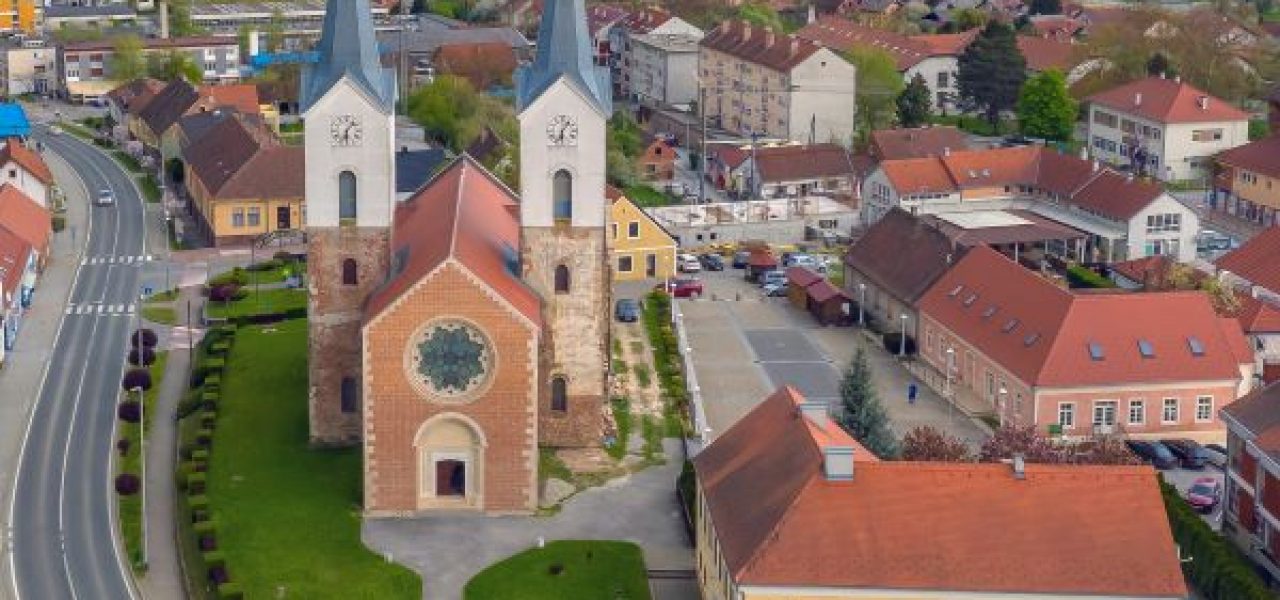INTRODUCTION
Located on the main town square, the Parish Church of Saint Mary Magdalene is the most important cultural site in Čazma. It is the only building still preserved from the golden age of the town – the Middle Ages.
Originally built as the Dominican church, next to their monastery (lost today), it was probably created around 1240. It is still unclear preciselly who built the church. However, it was an influential person because the Hungarian Royal stonemason workshop worked on its construction. In its style, the church is Romanesque-Gothic. The Romanesque features are mostly visible on its exterior. Especially representative is the large rose window on its main facade. Gothic, and later Baroque details, are present in the church interior.
With the combination of different architectural styles, Romanesque decoration of the highest quality, and its design with two towers, the church of Saint Mary Magdalene in Čazma is unique in Croatia and Central Europe.
HISTORY
Bishop Stephen II presumably initiated the construction of the medieval Church of Saint Mary Magdalene in the mid-13th century.
They were both influential figures of the time and closely linked to the Hungarian Árpád dynasty, which gave them the power to build a church that followed contemporary artistic currents. This is substantiated by the forms of the stone architectural decoration that suggest workshops connected to the Hungarian Royal court.
After being fatally wounded in the battle with Tatars on the Sajo River in 1241, Duke Coloman was buried inside the church. Unfortunately, his tombstone was lost from it in the second half of the 19th century. The reason for Čazma’s development during the Middle Ages lies in Bishop Stephen II’s decision to establish the second seat of Zagreb’s Diocese in that small town. He founded it in 1232 as a church administrative centre with twelve canons. They had their church of Saint Spirit in the wider area of nowadays cemetery. Besides the religious role, it also served as locus credibilis, a place where different kinds of documents could be notarized. Together with being home to some church orders, Čazma was the centre of culture and literacy in medieval central Croatia.
The church of Saint Mary Magdalene that was built as a Dominican church became the Parish Church of Čazma in 1653.
Although many more sacral buildings existed in the town during the Middle Ages, today only the Church of Saint Mary Magdalene is still preserved.
ARCHITECTURE AND FURNITURE
Because it was made of bricks, the Church of Saint Mary Magdalene is quite a unique medieval sacral building in Croatia. However, the Romanesque decoration such as rose window, portal and window openings made by the Royal workshop were created in stone. The Romanesque style is primarily visible on its exterior. The interior architecture has Gothic stylistic features, that are especially visible on pointed triumphant arches, supports, and some parts of the transept and side aisles.
The church can be defined as a Romanesque-Gothic building. Based on the archaeological excavations, it had two building phases. The first late Romanesque building had a single nave with a rectangular sanctuary preceded by a transept that initially had a role of side
chapels. At the centre of the main nave are a couple of bell towers whose ground floors, opened to the main nave, also had a function of chapels.
It was expanded in late medieval times, probably in the 14th century. That’s when it got two side naves in the eastern part – between the bell towers and the transept wings (chapels). One of its most impressive features is the massive western rose window. Its diameter of
more than six meters makes it one of the largest ones in Central European medieval architecture. The smaller rose window, with the diameter of four metres, is situated on the east wall of the rectangular sanctuary.
In the mid-18th century, the church was renovated in the Baroque style. The plaster covered medieval building elements, new window openings were made, a sacristy was added, new vaults were built, together with burial crypts and a choir for the organ.
Most of its furniture also comes from that time. Besides eight Baroque altars, one of its highlights is the Baroque pulpit instaled in 1753. And so is an organ made in Vienna in 1769 in the Roccoco style.
During the Classicist restoration in the 19th century, both bell towers were upgraded, highlighting the church’s dominant position in the area. This was when the medieval bell towers got two upper floors rebuilt at the end of the 19th and the beginning of the 20th century. The original medieval bell towers were probably the same height as the ones today..
OPENING HOURS
Only by appointment and for worship hours.
Sunday 11.00 until 12.00 am.
CONTACT
Trg Čazmanskog kaptola 14
43240 Čazma
Responsible person in the object:
Maja Cepetić Rogić
Mail: info@muzejcazma.eu
Phone: +385 43 771037
ENTRANCE FEES
-Free entry-
Guided tours available on request by the organizers at the Čazma Municipal Museum.
ROUTE SUGGESTIONS
- A TRANSROMANICA Day in Čazma
TOURIST INFORMATION OFFICE
Čazma Tourism Board:
Turistička zajednica Grada Čazme
Address: Braće Radića 2, 43240 Čazma
Email: tzc@email.t-com.hr
Phone: +385 (0)43 772 086 and +385 (0)99 2772 086


